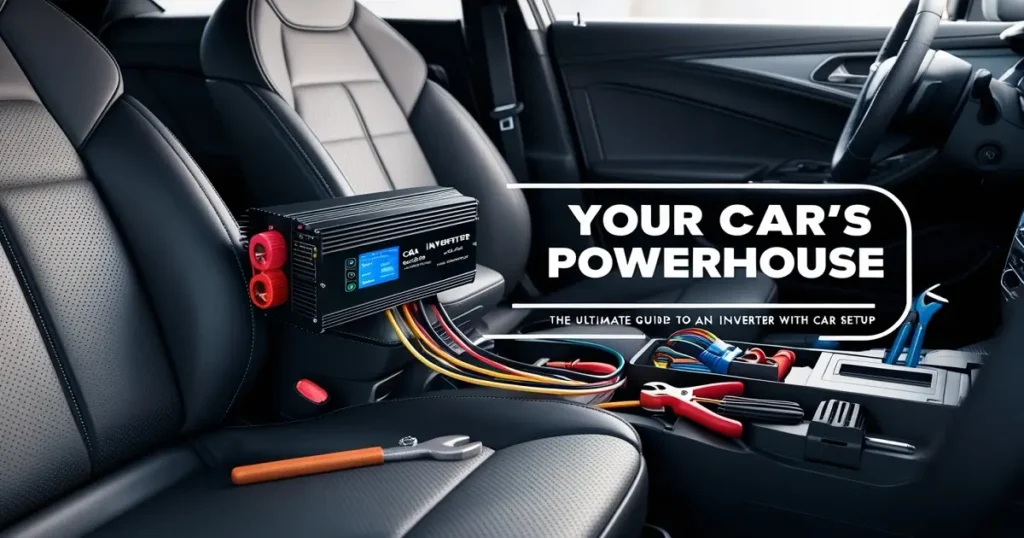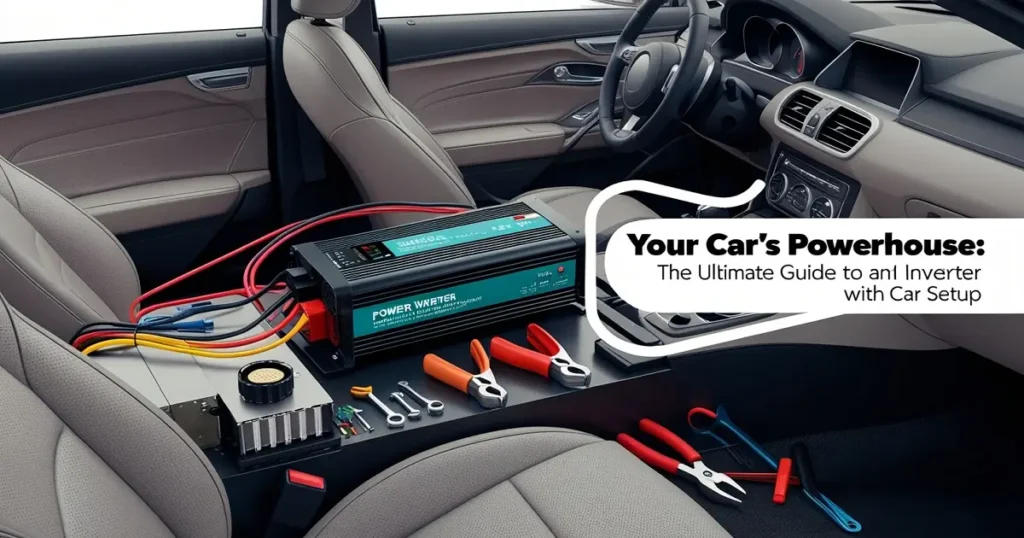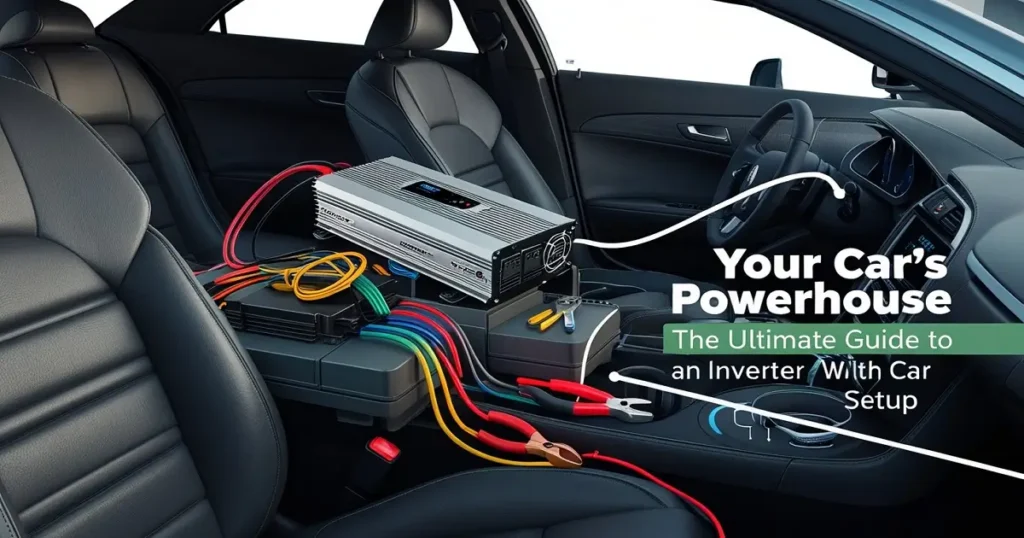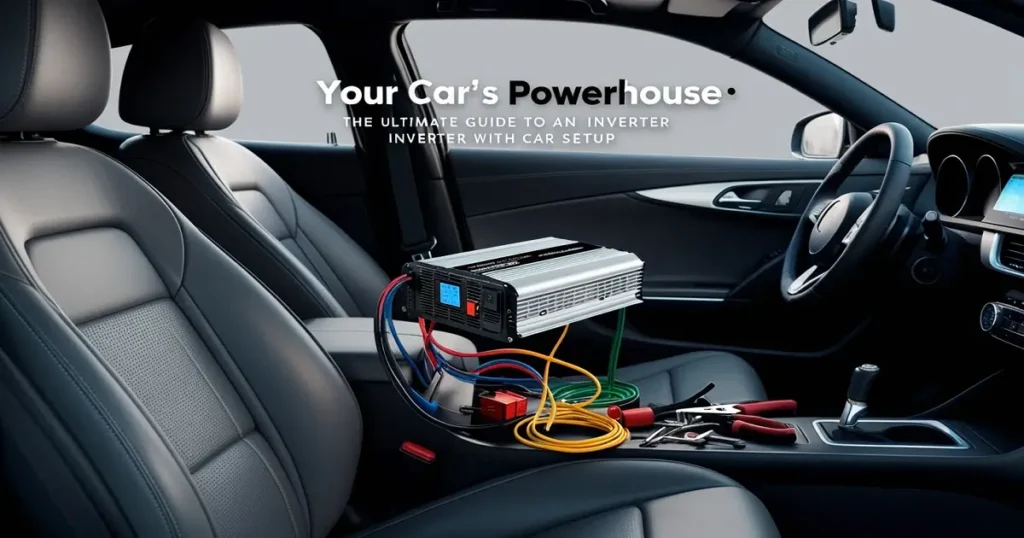Introduction: Unleash Your Car’s Inner Power Outlet
Imagine this: you’re on the perfect road trip. The scenery is stunning, your playlist is flawless, and then it happens—your phone battery blinks a terrifying 1%. Or maybe you need to power a small TV for tailgating, a laptop for a remote work emergency, or a mini-fridge for cool drinks. Your car is a marvel of modern engineering, but it doesn’t have a standard wall plug. That’s where the magic of an inverter with car setup comes in! This brilliant gadget is like a tiny, portable power plant for your vehicle, turning your car’s battery into a handy electrical outlet. It’s a game-changer for drivers, adventurers, and families alike. Think of it as the ultimate car accessory that bridges the gap between your home’s power and life on the road. It’s easier to use than you might think, and it can transform how you use your vehicle. In this guide, we’ll plug into everything you need to know about using an inverter with car technology. Let’s get powered up!
Table of Contents
What is an Inverter with Car Tech?
Alright, let’s break it down in simple terms. You know your car battery provides DC (Direct Current) power. It’s the type of electricity that flows in one direction, perfect for your car’s lights, radio, and starter. But the gadgets you love—your phone, laptop, coffee maker—need AC (Alternating Current) power. This is the type that comes from the walls in your house, where the current flows back and forth. An inverter with car compatibility is a clever little box that solves this problem. It takes the DC power from your car’s battery (or 12V outlet/cigarette lighter) and converts it into the AC power your devices crave. It’s like a bilingual translator for electricity! Ever wonder if your car is smarter than your phone? With an inverter, it just might be. It gives your vehicle a whole new skill, making it the most versatile tool in your adventure kit.

Why You’ll Love Using an Inverter with Your Car
Get ready to fall in love with your car all over again. Adding an inverter with car capabilities isn’t just about convenience; it’s about freedom. It unlocks a world of possibilities you probably never thought were possible from the driver’s seat.
- The Ultimate Road Trip Companion: Say goodbye to fighting over the single USB port. Keep every phone, tablet, and handheld game console charged for hours of peaceful travel. You can even plug in a small electric cooler for snacks and drinks!
- Turn Your SUV into an Office: For remote workers and digital nomads, your car can become a mobile command center. Power your laptop, a small monitor, and a WiFi hotspot anywhere you can park with a view. No more hunting for a coffee shop outlet.
- The Best Tailgating Party Trick: Be the hero of the parking lot. Power a small blender for smoothies, a TV to watch the pre-game show, or a string of lights to make your tailgate spot the envy of everyone.
- Essential for Emergencies: During a power outage at home, your car and inverter can become a backup power source for small essentials like lamps, phone chargers, or a radio.
- Hobbyists and Craftspeople Rejoice: Need to run power tools at a remote job site or a craft project in the great outdoors? A powerful inverter with car hookup can run drills, sanders, or small saws, as long as you have the wattage.
It saves you time, money on coffee shop lattes, and a ton of effort. It’s the Swiss Army knife of car electronics. Once you have one, you’ll wonder how you ever drove without it.

How to Use an Inverter with Car Systems
Quick Overview
Using an inverter with car electrical systems is designed to be incredibly simple. For small devices, you simply plug the inverter into your car’s 12-volt accessory outlet (the old cigarette lighter socket), and then plug your device into the inverter. It’s a plug-and-play setup that takes seconds. For larger power needs, the inverter connects directly to your car’s battery with special cables. This requires a bit more know-how but is still very manageable for most drivers.
Key Features of a Car Power Inverter
Not all inverters are created equal. When shopping for an inverter with car use, here’s what to look for:
- Wattage (Power): This is the most important feature. It tells you how much the inverter can handle. Small devices like phones need less than 100 watts. Laptops might need 150-300W. Kitchen appliances can need 750W or more. Always choose an inverter with a wattage rating higher than the device you want to power.
- Waveform: You’ll see “Modified Sine Wave” and “Pure Sine Wave.”
- Modified Sine Wave: More affordable and fine for simple electronics like phone chargers and tools.
- Pure Sine Wave: Produces cleaner, smoother electricity identical to your home’s power. Essential for sensitive electronics like medical equipment, high-end laptops, and audio equipment.
- Number of Outlets & USB Ports: How many things can you plug in at once? Most have at least one AC outlet and one or two USB ports.
- Safety Features: Look for protection against overloads, low battery voltage (so you don’t drain your car battery completely), overheating, and short circuits.
- Cooling Fan: A built-in fan helps prevent the inverter from overheating during extended use.
Step-by-Step Instructions: From Simple to Advanced
Use Case 1: The Simple Plug-In (For Low-Wattage Devices)
This is for inverters that plug into your 12V outlet (usually under 150-200 watts).
- Check Your Device’s Wattage: Look at the label on your phone charger, laptop power brick, or other device. It will say something like “Input: 100-240V – 50-60Hz, 1.5A.” You can calculate watts with this formula: Volts x Amps = Watts. So, 120V x 1.5A = 180 Watts. Or, just use the chart we provide later!
- Choose the Right Inverter: Select an inverter with a continuous wattage rating higher than your device’s requirement.
- Start Your Car’s Engine: This is crucial! Using an inverter with the engine off can drain your battery very quickly. Start the engine to ensure the alternator is replenishing the battery.
- Plug It In: Plug the inverter firmly into your car’s 12V outlet.
- Power Up: Plug your device into the inverter’s AC outlet or USB port.
- Unplug When Done: When finished, unplug your device first, then the inverter from the 12V outlet.
Use Case 2: The Direct-Connection (For High-Wattage Devices)
This is for larger inverters (typically 400 watts and above) that connect directly to the car battery.
- Gear Up: You’ll need the inverter, battery clamp cables (usually included), and a safe place to mount the inverter (where it won’t slide around or overheat).
- Safety First! Park in a well-ventilated area, turn the engine OFF, and engage the parking brake.
- Connect to the Battery: Identify the positive (+) and negative (-) terminals on your car battery.
- Attach the RED (positive) cable clamp to the positive (+) battery terminal.
- Attach the BLACK (negative) cable clamp to the negative (-) battery terminal or a solid, unpainted metal part of the chassis (a ground).
- Secure the Inverter: Place the inverter in a stable, dry location where the cables are not stretched or near hot engine parts.
- Start Your Engine: Now, start your car. You can now use the high-power outlets on the inverter.
- Disconnect Safely: When done, turn off all devices, turn off the engine, and disconnect the cables from the battery in reverse order (negative first, then positive).

What to Pair Your Car Power Inverter With
An inverter with car setup is powerful on its own, but it becomes part of an incredible ecosystem when paired with other gear.
- A Good Quality Battery Charger/Jump Starter: Since using an inverter can drain your battery, having a portable jump pack in your trunk is a brilliant safety net. It’s peace of mind.
- A Portable Air Compressor: Now that you have power, you can run a compressor to fill your tires anytime, anywhere. No more searching for a gas station with a working air pump!
- 12-Volt Electric Cooler/Warmer: This pairs perfectly. You can use the inverter for other things while the cooler plugs into the 12V outlet, keeping your food and drinks at the perfect temperature for hours.
- A Tire Inflator: Similar to the compressor, but often all-in-one units are designed for car use.
- A Dash Cam: While a dash cam usually plugs into the 12V outlet, if you’re using that for your inverter, a hardwiring kit for your dash cam can keep it running even when the car is off (if you choose that setting).
Top Tips for Mastering Your Inverter with Car Setup
Becoming a power user is easy with these pro tips and common mistakes to avoid.
- Tip 1: Calculate Your Wattage Needs. Add up the watts of everything you want to run at once, then add a 20-25% buffer. This is the minimum continuous wattage your inverter should have. See the chart below for common devices!
- Tip 2: NEVER Drain Your Battery. Always run your car’s engine when using the inverter, especially for more than a few minutes. A dead battery on a remote road is no fun.
- Tip 3: Start with the Engine Running. For devices with motors (like a cooler or drill), the initial “startup” power (surge wattage) can be 2-3 times higher than their running wattage. Your inverter needs to handle this surge. Starting your car engine first provides the most stable power.
- Tip 4: Keep it Ventilated. Inverters generate heat. Don’t bury it under a jacket or pillow. Make sure its cooling fan has space to breathe.
- Mistake to Avoid: Do not try to power large appliances like hair dryers, air conditioners, or microwave ovens with a standard inverter with car connection. They require far more power than a car’s electrical system is designed to provide and can be a fire hazard.
Common Device Wattage Chart
| Device | Approximate Wattage Needed (Running) | Recommended Inverter Size |
|---|---|---|
| Phone Charger | 5 – 25W | 100W |
| Laptop | 90 – 150W | 300W |
| Tablet | 30 – 50W | 100W |
| LED TV (32″) | 50 – 100W | 300W |
| Small Fan | 25 – 75W | 100W |
| DSLR Camera Battery Charger | 50 – 70W | 100W |
| Game Console (e.g., PlayStation) | 100 – 200W | 400W |
| Electric Cooler (12V) | 40 – 60W | 100W |
| Blender (Small) | 300 – 400W | 750W |
| Drill (Cordless Charger) | 70 – 120W | 300W |

How to Stay Updated with Car Inverter Tech
The world of car tech is always moving! To stay in the know about the latest in inverter with car technology and other automotive gadgets:
- Follow Automotive Tech Blogs and Websites: Sites like Car and Driver, Road & Track, and The Drive often have tech sections that review the latest gear.
- Subscribe to YouTube Channels: Channels like ChrisFix, Engineering Explained, and Scotty Kilmer often do hands-on reviews and tutorials about car electronics and accessories in an easy-to-understand way.
- Join Online Forums: Reddit communities like r/automotive, r/MechanicAdvice, or r/VEDC (Vehicle Every Day Carry) are full of enthusiasts who share their real-world experiences, setups, and reviews.
- Sign Up for Retailer Newsletters: Companies that sell inverters, like Best Buy, Amazon, or specialty auto parts stores, often send out emails featuring new products and tech innovations.
- Follow Brands on Social Media: If you have an inverter brand you like, follow them on Instagram, Twitter, or Facebook. They’ll announce new models and features there first.
Conclusion: Power Your Journeys
An inverter with car integration is more than just a gadget; it’s a key that unlocks the full potential of your vehicle. It empowers you to work, play, and relax wherever the road takes you, without ever worrying about a dead battery on your devices. It’s about convenience, safety, and opening up a new world of adventures. From the simple road trip to the ambitious cross-country journey, having AC power on demand makes everything easier and more enjoyable. We hope this guide has demystified the process and shown you just how easy and beneficial it is to add an inverter to your car life.
Strong Call-to-Action
Ready to transform your car into a rolling power outlet? What’s the first thing you’d power with your new setup? Tell us your dream inverter with car project in the comments below! And if you found this guide helpful, share it with a friend who loves a good road trip or could use a mobile office. Don’t forget to subscribe to our newsletter for more tips, tricks, and reviews to get the most out of your vehicle!